BUS3154M-3-1718: Defence Support Chain Operation and Movements Report
VerifiedAdded on 2022/12/29
|16
|3876
|58
Report
AI Summary
This report provides a detailed analysis of the supply chain for Defence Support Chain Operation and Movements, focusing on its influence on the success of the British Army. It explores key aspects such as planning, sourcing, supplier production, and delivery systems. The report emphasizes the importance of strategic supply chain management, including tactical and operational strategies, design and development of distribution channels, and the adoption of a reverse supply chain strategy. Furthermore, it highlights the need for enhanced monitoring and evaluation of products, real-time inventory management, and standardization of products and services. The report underscores the significance of efficient supply chain management in achieving competitive advantage and operational success within the British Army, emphasizing the need for managers to understand and address various issues related to supply chain design and execution. The report also discusses the importance of adopting supply chain management processes and associated technologies for improved efficiency and effectiveness. References from Christopher, Hugos, Marchesini, Esmaeilikia, Kim, Coyle, Ralston and Lin are used to support the arguments made.
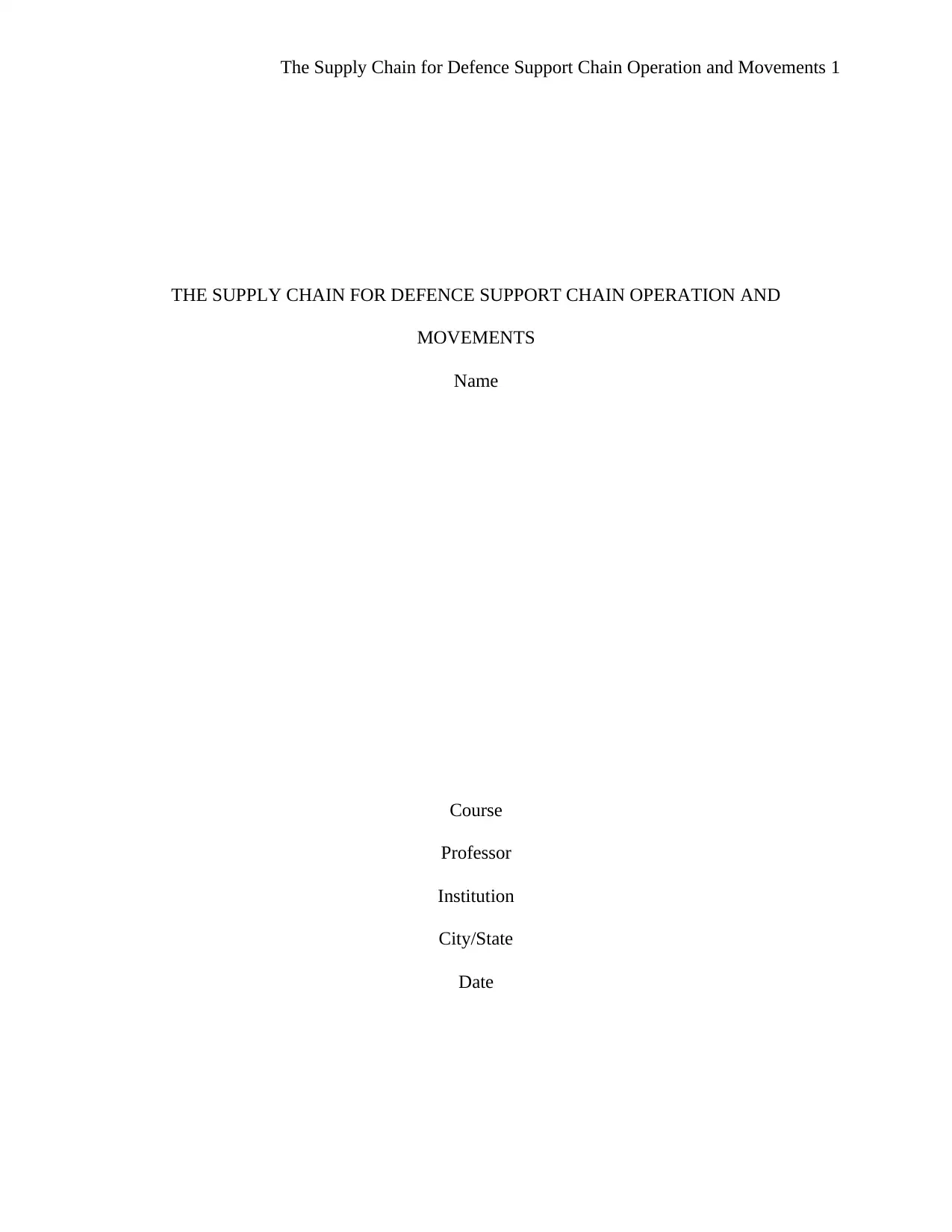
The Supply Chain for Defence Support Chain Operation and Movements 1
THE SUPPLY CHAIN FOR DEFENCE SUPPORT CHAIN OPERATION AND
MOVEMENTS
Name
Course
Professor
Institution
City/State
Date
THE SUPPLY CHAIN FOR DEFENCE SUPPORT CHAIN OPERATION AND
MOVEMENTS
Name
Course
Professor
Institution
City/State
Date
Paraphrase This Document
Need a fresh take? Get an instant paraphrase of this document with our AI Paraphraser
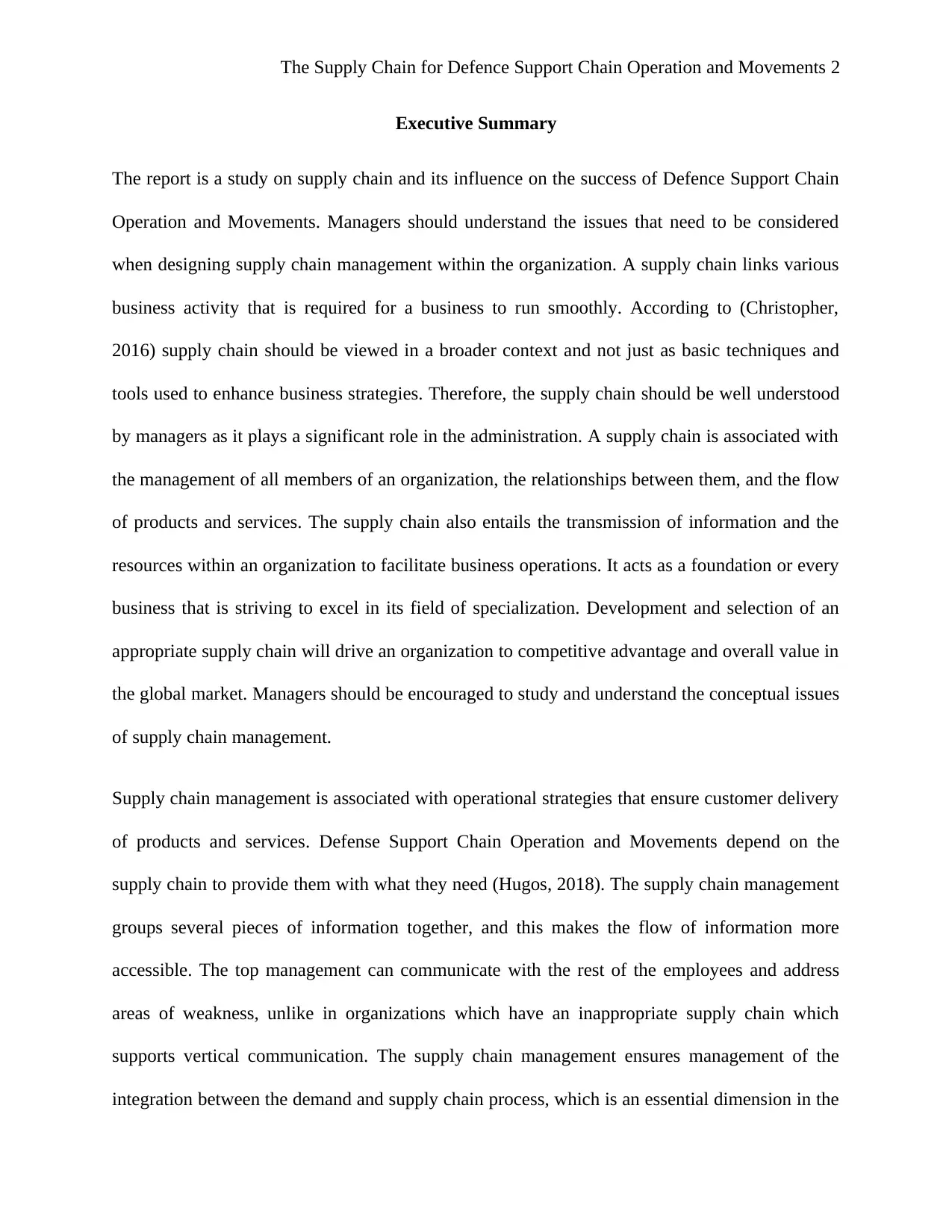
The Supply Chain for Defence Support Chain Operation and Movements 2
Executive Summary
The report is a study on supply chain and its influence on the success of Defence Support Chain
Operation and Movements. Managers should understand the issues that need to be considered
when designing supply chain management within the organization. A supply chain links various
business activity that is required for a business to run smoothly. According to (Christopher,
2016) supply chain should be viewed in a broader context and not just as basic techniques and
tools used to enhance business strategies. Therefore, the supply chain should be well understood
by managers as it plays a significant role in the administration. A supply chain is associated with
the management of all members of an organization, the relationships between them, and the flow
of products and services. The supply chain also entails the transmission of information and the
resources within an organization to facilitate business operations. It acts as a foundation or every
business that is striving to excel in its field of specialization. Development and selection of an
appropriate supply chain will drive an organization to competitive advantage and overall value in
the global market. Managers should be encouraged to study and understand the conceptual issues
of supply chain management.
Supply chain management is associated with operational strategies that ensure customer delivery
of products and services. Defense Support Chain Operation and Movements depend on the
supply chain to provide them with what they need (Hugos, 2018). The supply chain management
groups several pieces of information together, and this makes the flow of information more
accessible. The top management can communicate with the rest of the employees and address
areas of weakness, unlike in organizations which have an inappropriate supply chain which
supports vertical communication. The supply chain management ensures management of the
integration between the demand and supply chain process, which is an essential dimension in the
Executive Summary
The report is a study on supply chain and its influence on the success of Defence Support Chain
Operation and Movements. Managers should understand the issues that need to be considered
when designing supply chain management within the organization. A supply chain links various
business activity that is required for a business to run smoothly. According to (Christopher,
2016) supply chain should be viewed in a broader context and not just as basic techniques and
tools used to enhance business strategies. Therefore, the supply chain should be well understood
by managers as it plays a significant role in the administration. A supply chain is associated with
the management of all members of an organization, the relationships between them, and the flow
of products and services. The supply chain also entails the transmission of information and the
resources within an organization to facilitate business operations. It acts as a foundation or every
business that is striving to excel in its field of specialization. Development and selection of an
appropriate supply chain will drive an organization to competitive advantage and overall value in
the global market. Managers should be encouraged to study and understand the conceptual issues
of supply chain management.
Supply chain management is associated with operational strategies that ensure customer delivery
of products and services. Defense Support Chain Operation and Movements depend on the
supply chain to provide them with what they need (Hugos, 2018). The supply chain management
groups several pieces of information together, and this makes the flow of information more
accessible. The top management can communicate with the rest of the employees and address
areas of weakness, unlike in organizations which have an inappropriate supply chain which
supports vertical communication. The supply chain management ensures management of the
integration between the demand and supply chain process, which is an essential dimension in the
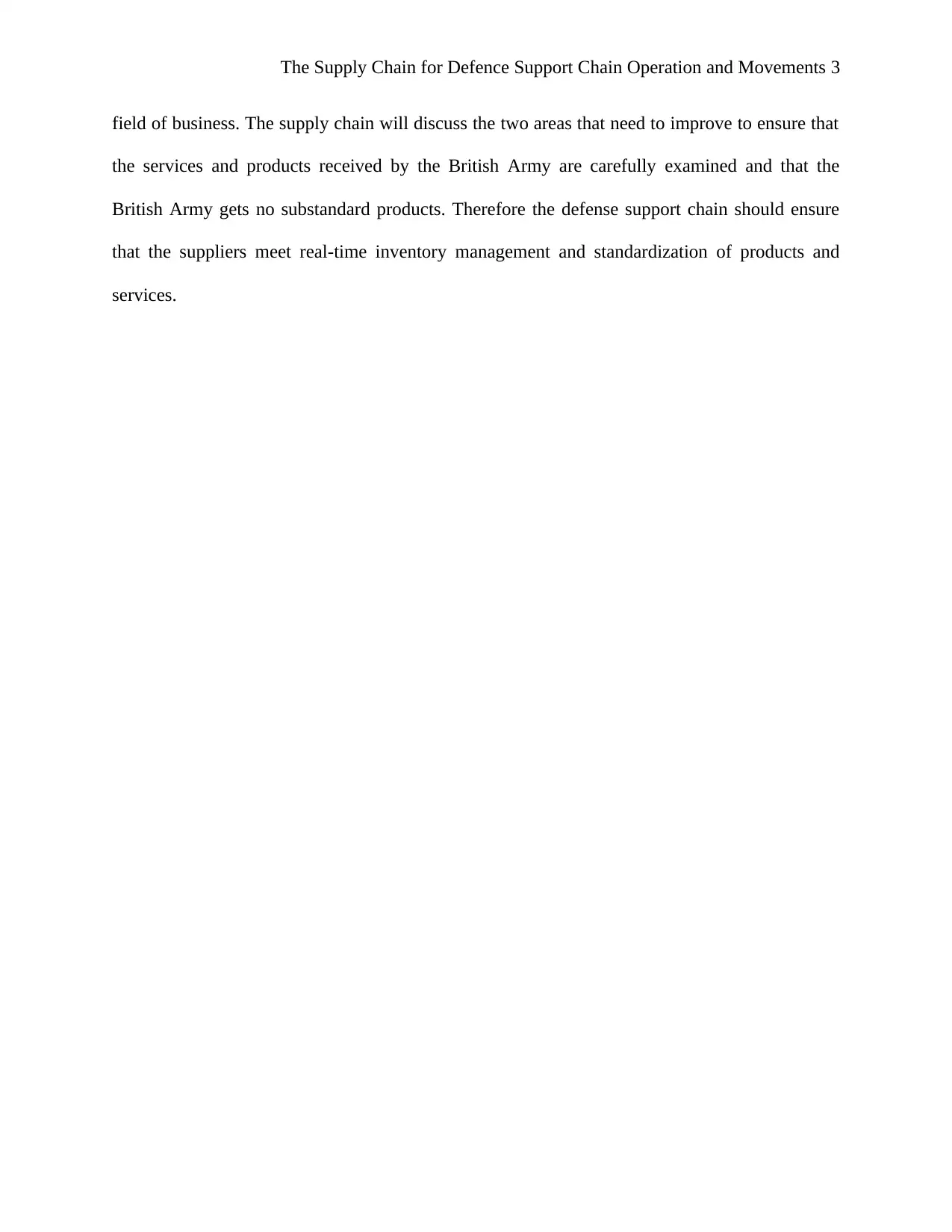
The Supply Chain for Defence Support Chain Operation and Movements 3
field of business. The supply chain will discuss the two areas that need to improve to ensure that
the services and products received by the British Army are carefully examined and that the
British Army gets no substandard products. Therefore the defense support chain should ensure
that the suppliers meet real-time inventory management and standardization of products and
services.
field of business. The supply chain will discuss the two areas that need to improve to ensure that
the services and products received by the British Army are carefully examined and that the
British Army gets no substandard products. Therefore the defense support chain should ensure
that the suppliers meet real-time inventory management and standardization of products and
services.
⊘ This is a preview!⊘
Do you want full access?
Subscribe today to unlock all pages.

Trusted by 1+ million students worldwide
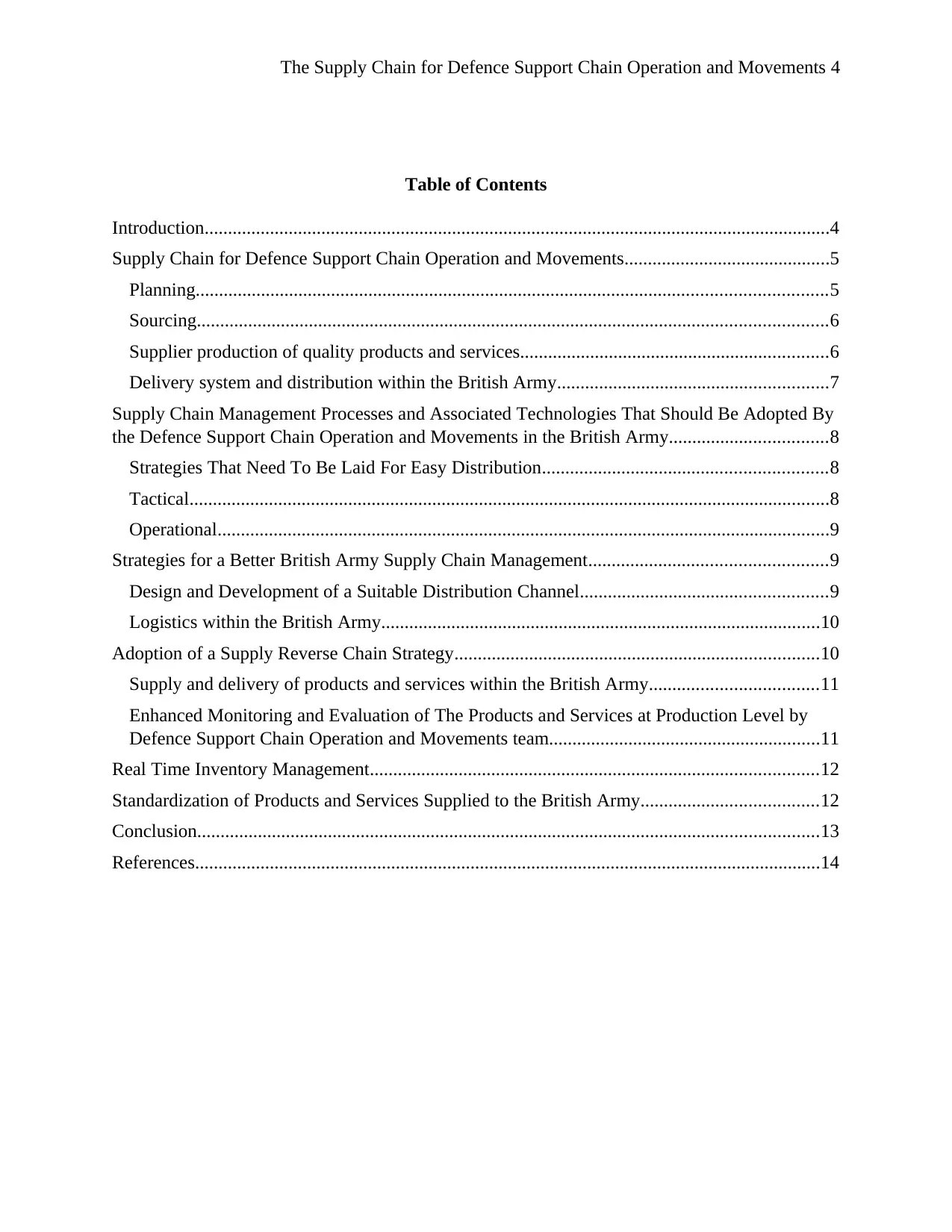
The Supply Chain for Defence Support Chain Operation and Movements 4
Table of Contents
Introduction......................................................................................................................................4
Supply Chain for Defence Support Chain Operation and Movements............................................5
Planning.......................................................................................................................................5
Sourcing.......................................................................................................................................6
Supplier production of quality products and services..................................................................6
Delivery system and distribution within the British Army..........................................................7
Supply Chain Management Processes and Associated Technologies That Should Be Adopted By
the Defence Support Chain Operation and Movements in the British Army..................................8
Strategies That Need To Be Laid For Easy Distribution.............................................................8
Tactical.........................................................................................................................................8
Operational...................................................................................................................................9
Strategies for a Better British Army Supply Chain Management...................................................9
Design and Development of a Suitable Distribution Channel.....................................................9
Logistics within the British Army..............................................................................................10
Adoption of a Supply Reverse Chain Strategy..............................................................................10
Supply and delivery of products and services within the British Army....................................11
Enhanced Monitoring and Evaluation of The Products and Services at Production Level by
Defence Support Chain Operation and Movements team..........................................................11
Real Time Inventory Management................................................................................................12
Standardization of Products and Services Supplied to the British Army......................................12
Conclusion.....................................................................................................................................13
References......................................................................................................................................14
Table of Contents
Introduction......................................................................................................................................4
Supply Chain for Defence Support Chain Operation and Movements............................................5
Planning.......................................................................................................................................5
Sourcing.......................................................................................................................................6
Supplier production of quality products and services..................................................................6
Delivery system and distribution within the British Army..........................................................7
Supply Chain Management Processes and Associated Technologies That Should Be Adopted By
the Defence Support Chain Operation and Movements in the British Army..................................8
Strategies That Need To Be Laid For Easy Distribution.............................................................8
Tactical.........................................................................................................................................8
Operational...................................................................................................................................9
Strategies for a Better British Army Supply Chain Management...................................................9
Design and Development of a Suitable Distribution Channel.....................................................9
Logistics within the British Army..............................................................................................10
Adoption of a Supply Reverse Chain Strategy..............................................................................10
Supply and delivery of products and services within the British Army....................................11
Enhanced Monitoring and Evaluation of The Products and Services at Production Level by
Defence Support Chain Operation and Movements team..........................................................11
Real Time Inventory Management................................................................................................12
Standardization of Products and Services Supplied to the British Army......................................12
Conclusion.....................................................................................................................................13
References......................................................................................................................................14
Paraphrase This Document
Need a fresh take? Get an instant paraphrase of this document with our AI Paraphraser
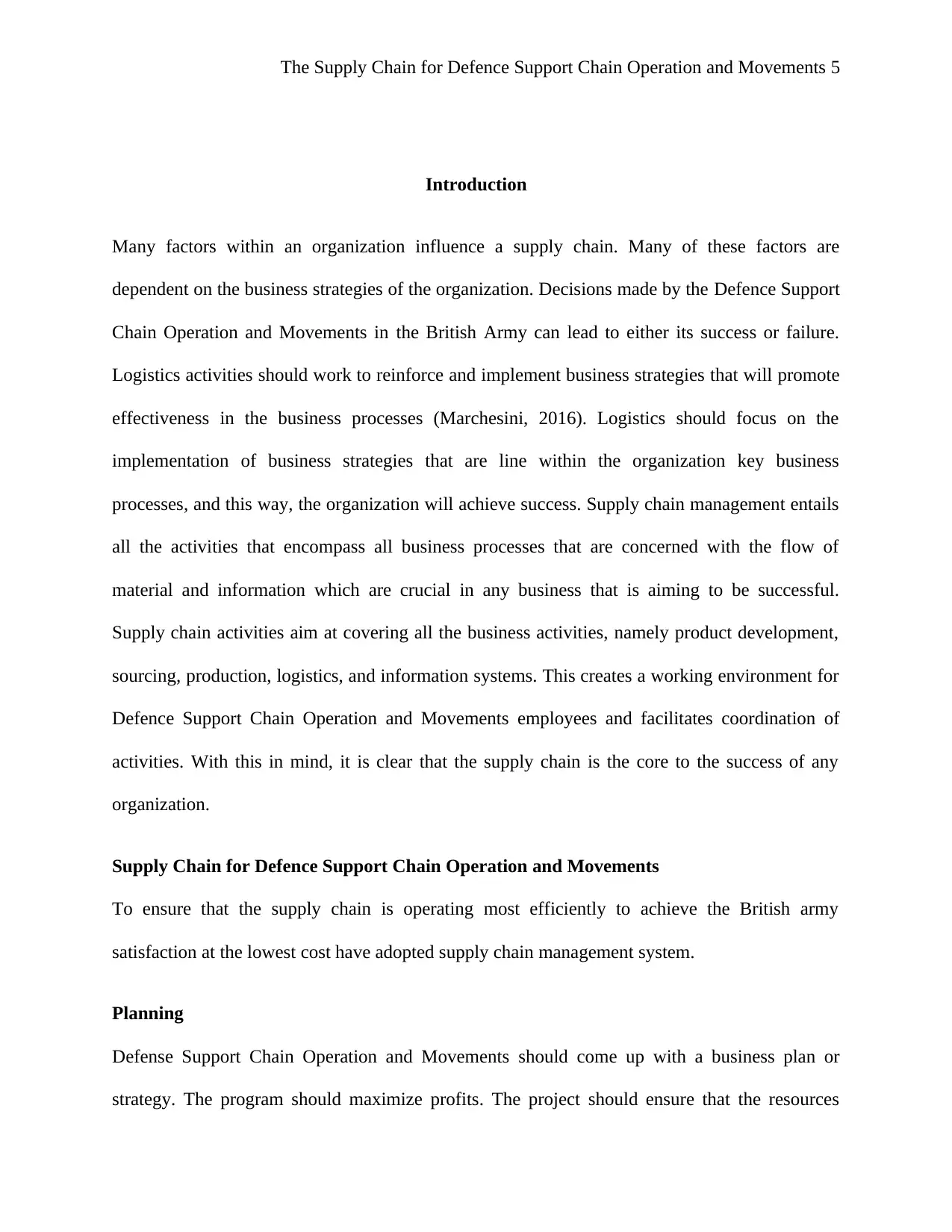
The Supply Chain for Defence Support Chain Operation and Movements 5
Introduction
Many factors within an organization influence a supply chain. Many of these factors are
dependent on the business strategies of the organization. Decisions made by the Defence Support
Chain Operation and Movements in the British Army can lead to either its success or failure.
Logistics activities should work to reinforce and implement business strategies that will promote
effectiveness in the business processes (Marchesini, 2016). Logistics should focus on the
implementation of business strategies that are line within the organization key business
processes, and this way, the organization will achieve success. Supply chain management entails
all the activities that encompass all business processes that are concerned with the flow of
material and information which are crucial in any business that is aiming to be successful.
Supply chain activities aim at covering all the business activities, namely product development,
sourcing, production, logistics, and information systems. This creates a working environment for
Defence Support Chain Operation and Movements employees and facilitates coordination of
activities. With this in mind, it is clear that the supply chain is the core to the success of any
organization.
Supply Chain for Defence Support Chain Operation and Movements
To ensure that the supply chain is operating most efficiently to achieve the British army
satisfaction at the lowest cost have adopted supply chain management system.
Planning
Defense Support Chain Operation and Movements should come up with a business plan or
strategy. The program should maximize profits. The project should ensure that the resources
Introduction
Many factors within an organization influence a supply chain. Many of these factors are
dependent on the business strategies of the organization. Decisions made by the Defence Support
Chain Operation and Movements in the British Army can lead to either its success or failure.
Logistics activities should work to reinforce and implement business strategies that will promote
effectiveness in the business processes (Marchesini, 2016). Logistics should focus on the
implementation of business strategies that are line within the organization key business
processes, and this way, the organization will achieve success. Supply chain management entails
all the activities that encompass all business processes that are concerned with the flow of
material and information which are crucial in any business that is aiming to be successful.
Supply chain activities aim at covering all the business activities, namely product development,
sourcing, production, logistics, and information systems. This creates a working environment for
Defence Support Chain Operation and Movements employees and facilitates coordination of
activities. With this in mind, it is clear that the supply chain is the core to the success of any
organization.
Supply Chain for Defence Support Chain Operation and Movements
To ensure that the supply chain is operating most efficiently to achieve the British army
satisfaction at the lowest cost have adopted supply chain management system.
Planning
Defense Support Chain Operation and Movements should come up with a business plan or
strategy. The program should maximize profits. The project should ensure that the resources
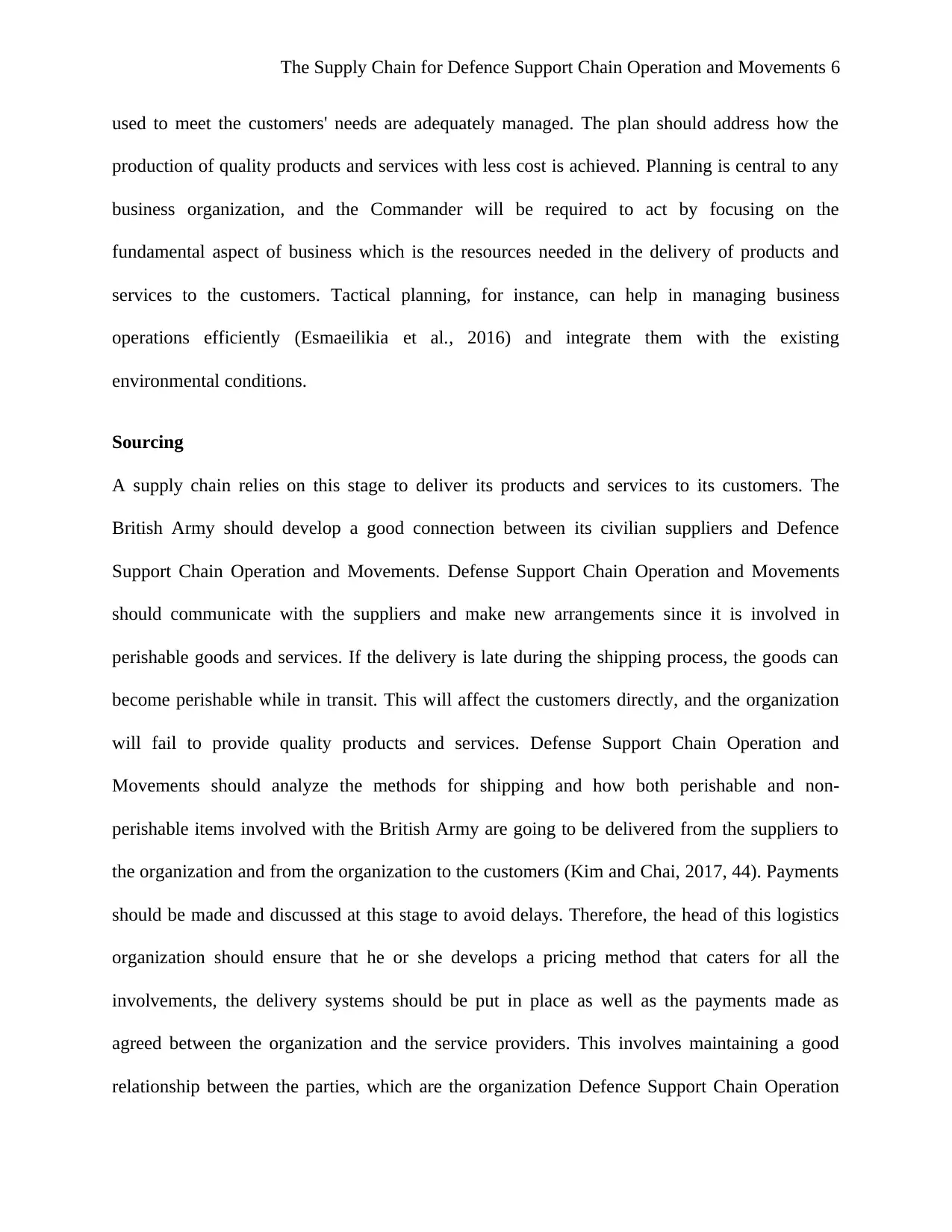
The Supply Chain for Defence Support Chain Operation and Movements 6
used to meet the customers' needs are adequately managed. The plan should address how the
production of quality products and services with less cost is achieved. Planning is central to any
business organization, and the Commander will be required to act by focusing on the
fundamental aspect of business which is the resources needed in the delivery of products and
services to the customers. Tactical planning, for instance, can help in managing business
operations efficiently (Esmaeilikia et al., 2016) and integrate them with the existing
environmental conditions.
Sourcing
A supply chain relies on this stage to deliver its products and services to its customers. The
British Army should develop a good connection between its civilian suppliers and Defence
Support Chain Operation and Movements. Defense Support Chain Operation and Movements
should communicate with the suppliers and make new arrangements since it is involved in
perishable goods and services. If the delivery is late during the shipping process, the goods can
become perishable while in transit. This will affect the customers directly, and the organization
will fail to provide quality products and services. Defense Support Chain Operation and
Movements should analyze the methods for shipping and how both perishable and non-
perishable items involved with the British Army are going to be delivered from the suppliers to
the organization and from the organization to the customers (Kim and Chai, 2017, 44). Payments
should be made and discussed at this stage to avoid delays. Therefore, the head of this logistics
organization should ensure that he or she develops a pricing method that caters for all the
involvements, the delivery systems should be put in place as well as the payments made as
agreed between the organization and the service providers. This involves maintaining a good
relationship between the parties, which are the organization Defence Support Chain Operation
used to meet the customers' needs are adequately managed. The plan should address how the
production of quality products and services with less cost is achieved. Planning is central to any
business organization, and the Commander will be required to act by focusing on the
fundamental aspect of business which is the resources needed in the delivery of products and
services to the customers. Tactical planning, for instance, can help in managing business
operations efficiently (Esmaeilikia et al., 2016) and integrate them with the existing
environmental conditions.
Sourcing
A supply chain relies on this stage to deliver its products and services to its customers. The
British Army should develop a good connection between its civilian suppliers and Defence
Support Chain Operation and Movements. Defense Support Chain Operation and Movements
should communicate with the suppliers and make new arrangements since it is involved in
perishable goods and services. If the delivery is late during the shipping process, the goods can
become perishable while in transit. This will affect the customers directly, and the organization
will fail to provide quality products and services. Defense Support Chain Operation and
Movements should analyze the methods for shipping and how both perishable and non-
perishable items involved with the British Army are going to be delivered from the suppliers to
the organization and from the organization to the customers (Kim and Chai, 2017, 44). Payments
should be made and discussed at this stage to avoid delays. Therefore, the head of this logistics
organization should ensure that he or she develops a pricing method that caters for all the
involvements, the delivery systems should be put in place as well as the payments made as
agreed between the organization and the service providers. This involves maintaining a good
relationship between the parties, which are the organization Defence Support Chain Operation
⊘ This is a preview!⊘
Do you want full access?
Subscribe today to unlock all pages.

Trusted by 1+ million students worldwide
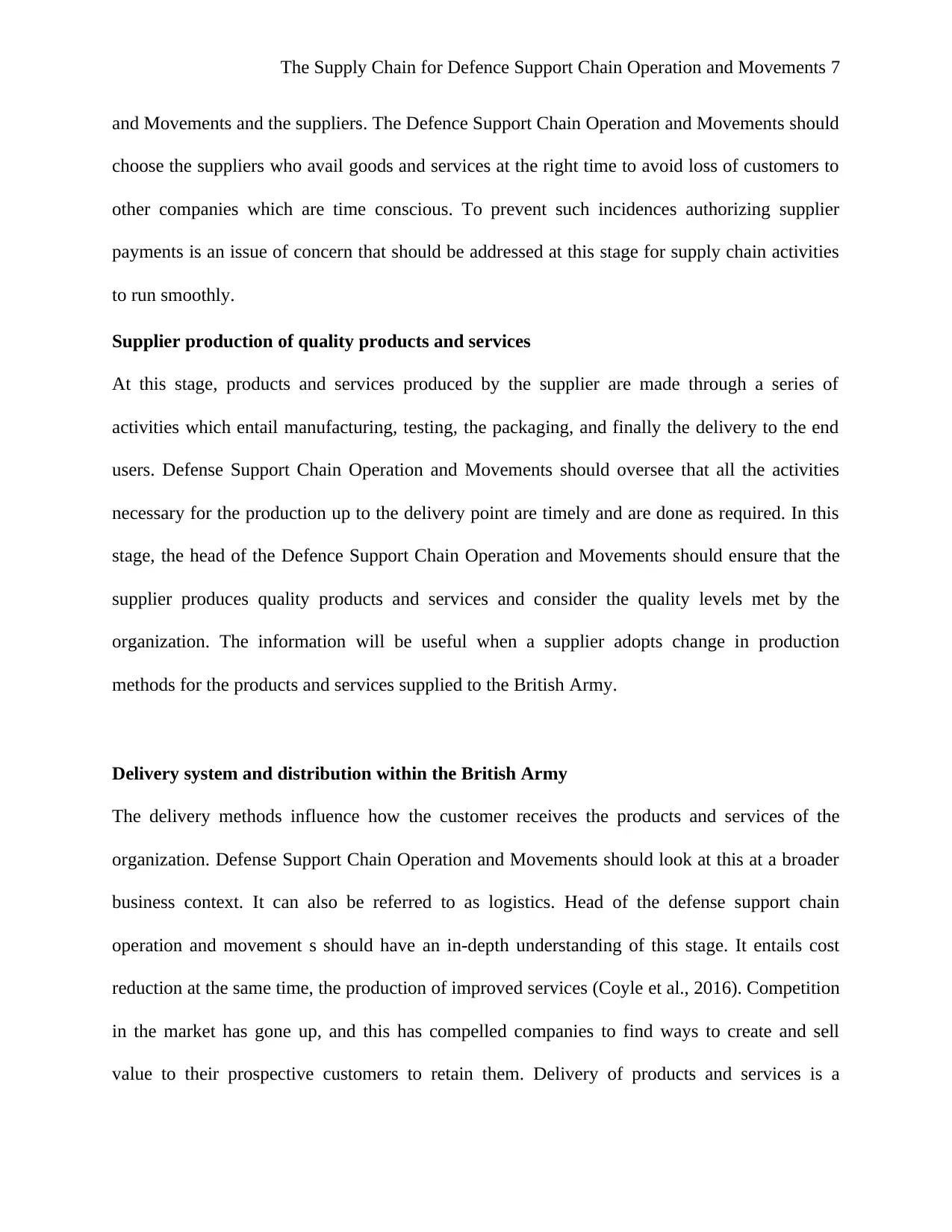
The Supply Chain for Defence Support Chain Operation and Movements 7
and Movements and the suppliers. The Defence Support Chain Operation and Movements should
choose the suppliers who avail goods and services at the right time to avoid loss of customers to
other companies which are time conscious. To prevent such incidences authorizing supplier
payments is an issue of concern that should be addressed at this stage for supply chain activities
to run smoothly.
Supplier production of quality products and services
At this stage, products and services produced by the supplier are made through a series of
activities which entail manufacturing, testing, the packaging, and finally the delivery to the end
users. Defense Support Chain Operation and Movements should oversee that all the activities
necessary for the production up to the delivery point are timely and are done as required. In this
stage, the head of the Defence Support Chain Operation and Movements should ensure that the
supplier produces quality products and services and consider the quality levels met by the
organization. The information will be useful when a supplier adopts change in production
methods for the products and services supplied to the British Army.
Delivery system and distribution within the British Army
The delivery methods influence how the customer receives the products and services of the
organization. Defense Support Chain Operation and Movements should look at this at a broader
business context. It can also be referred to as logistics. Head of the defense support chain
operation and movement s should have an in-depth understanding of this stage. It entails cost
reduction at the same time, the production of improved services (Coyle et al., 2016). Competition
in the market has gone up, and this has compelled companies to find ways to create and sell
value to their prospective customers to retain them. Delivery of products and services is a
and Movements and the suppliers. The Defence Support Chain Operation and Movements should
choose the suppliers who avail goods and services at the right time to avoid loss of customers to
other companies which are time conscious. To prevent such incidences authorizing supplier
payments is an issue of concern that should be addressed at this stage for supply chain activities
to run smoothly.
Supplier production of quality products and services
At this stage, products and services produced by the supplier are made through a series of
activities which entail manufacturing, testing, the packaging, and finally the delivery to the end
users. Defense Support Chain Operation and Movements should oversee that all the activities
necessary for the production up to the delivery point are timely and are done as required. In this
stage, the head of the Defence Support Chain Operation and Movements should ensure that the
supplier produces quality products and services and consider the quality levels met by the
organization. The information will be useful when a supplier adopts change in production
methods for the products and services supplied to the British Army.
Delivery system and distribution within the British Army
The delivery methods influence how the customer receives the products and services of the
organization. Defense Support Chain Operation and Movements should look at this at a broader
business context. It can also be referred to as logistics. Head of the defense support chain
operation and movement s should have an in-depth understanding of this stage. It entails cost
reduction at the same time, the production of improved services (Coyle et al., 2016). Competition
in the market has gone up, and this has compelled companies to find ways to create and sell
value to their prospective customers to retain them. Delivery of products and services is a
Paraphrase This Document
Need a fresh take? Get an instant paraphrase of this document with our AI Paraphraser
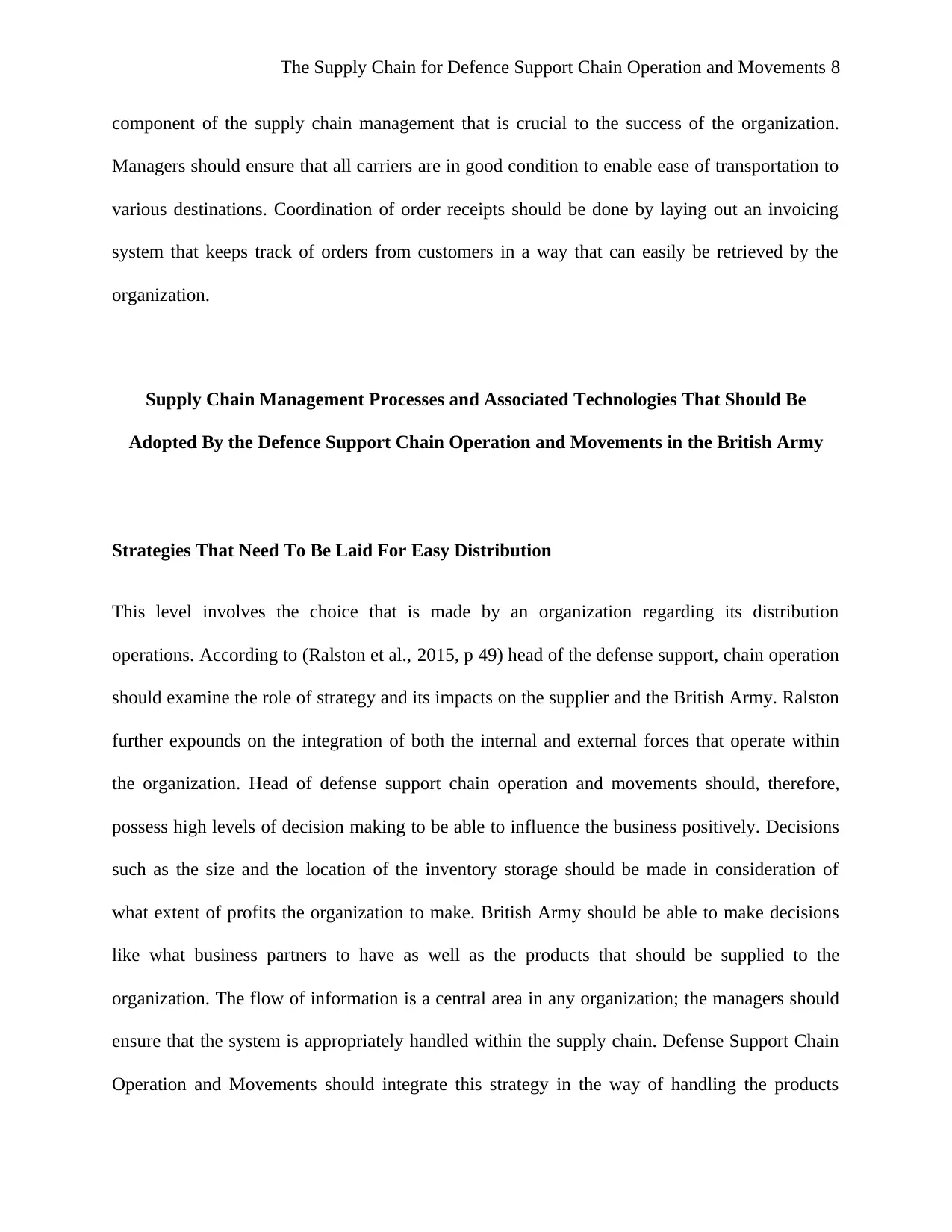
The Supply Chain for Defence Support Chain Operation and Movements 8
component of the supply chain management that is crucial to the success of the organization.
Managers should ensure that all carriers are in good condition to enable ease of transportation to
various destinations. Coordination of order receipts should be done by laying out an invoicing
system that keeps track of orders from customers in a way that can easily be retrieved by the
organization.
Supply Chain Management Processes and Associated Technologies That Should Be
Adopted By the Defence Support Chain Operation and Movements in the British Army
Strategies That Need To Be Laid For Easy Distribution
This level involves the choice that is made by an organization regarding its distribution
operations. According to (Ralston et al., 2015, p 49) head of the defense support, chain operation
should examine the role of strategy and its impacts on the supplier and the British Army. Ralston
further expounds on the integration of both the internal and external forces that operate within
the organization. Head of defense support chain operation and movements should, therefore,
possess high levels of decision making to be able to influence the business positively. Decisions
such as the size and the location of the inventory storage should be made in consideration of
what extent of profits the organization to make. British Army should be able to make decisions
like what business partners to have as well as the products that should be supplied to the
organization. The flow of information is a central area in any organization; the managers should
ensure that the system is appropriately handled within the supply chain. Defense Support Chain
Operation and Movements should integrate this strategy in the way of handling the products
component of the supply chain management that is crucial to the success of the organization.
Managers should ensure that all carriers are in good condition to enable ease of transportation to
various destinations. Coordination of order receipts should be done by laying out an invoicing
system that keeps track of orders from customers in a way that can easily be retrieved by the
organization.
Supply Chain Management Processes and Associated Technologies That Should Be
Adopted By the Defence Support Chain Operation and Movements in the British Army
Strategies That Need To Be Laid For Easy Distribution
This level involves the choice that is made by an organization regarding its distribution
operations. According to (Ralston et al., 2015, p 49) head of the defense support, chain operation
should examine the role of strategy and its impacts on the supplier and the British Army. Ralston
further expounds on the integration of both the internal and external forces that operate within
the organization. Head of defense support chain operation and movements should, therefore,
possess high levels of decision making to be able to influence the business positively. Decisions
such as the size and the location of the inventory storage should be made in consideration of
what extent of profits the organization to make. British Army should be able to make decisions
like what business partners to have as well as the products that should be supplied to the
organization. The flow of information is a central area in any organization; the managers should
ensure that the system is appropriately handled within the supply chain. Defense Support Chain
Operation and Movements should integrate this strategy in the way of handling the products
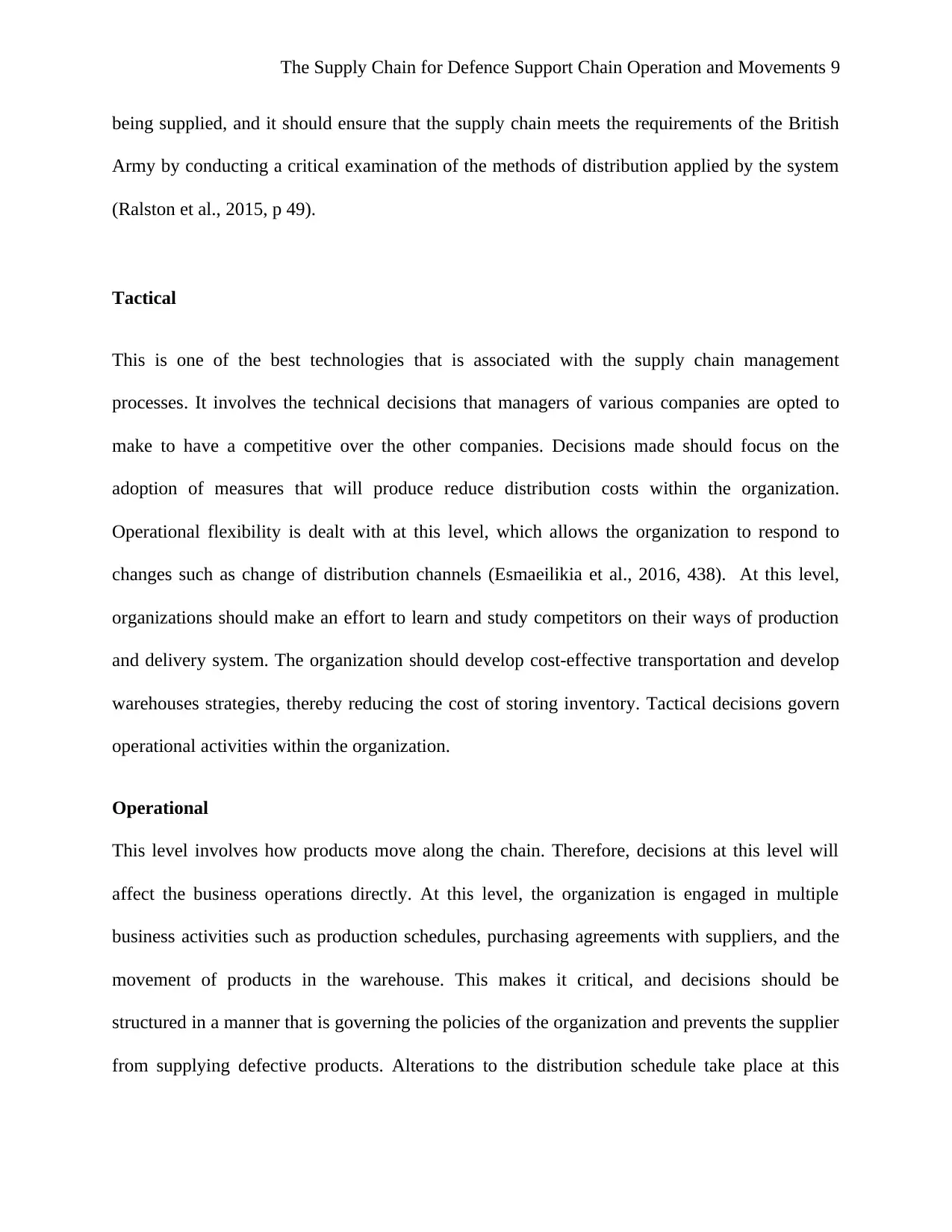
The Supply Chain for Defence Support Chain Operation and Movements 9
being supplied, and it should ensure that the supply chain meets the requirements of the British
Army by conducting a critical examination of the methods of distribution applied by the system
(Ralston et al., 2015, p 49).
Tactical
This is one of the best technologies that is associated with the supply chain management
processes. It involves the technical decisions that managers of various companies are opted to
make to have a competitive over the other companies. Decisions made should focus on the
adoption of measures that will produce reduce distribution costs within the organization.
Operational flexibility is dealt with at this level, which allows the organization to respond to
changes such as change of distribution channels (Esmaeilikia et al., 2016, 438). At this level,
organizations should make an effort to learn and study competitors on their ways of production
and delivery system. The organization should develop cost-effective transportation and develop
warehouses strategies, thereby reducing the cost of storing inventory. Tactical decisions govern
operational activities within the organization.
Operational
This level involves how products move along the chain. Therefore, decisions at this level will
affect the business operations directly. At this level, the organization is engaged in multiple
business activities such as production schedules, purchasing agreements with suppliers, and the
movement of products in the warehouse. This makes it critical, and decisions should be
structured in a manner that is governing the policies of the organization and prevents the supplier
from supplying defective products. Alterations to the distribution schedule take place at this
being supplied, and it should ensure that the supply chain meets the requirements of the British
Army by conducting a critical examination of the methods of distribution applied by the system
(Ralston et al., 2015, p 49).
Tactical
This is one of the best technologies that is associated with the supply chain management
processes. It involves the technical decisions that managers of various companies are opted to
make to have a competitive over the other companies. Decisions made should focus on the
adoption of measures that will produce reduce distribution costs within the organization.
Operational flexibility is dealt with at this level, which allows the organization to respond to
changes such as change of distribution channels (Esmaeilikia et al., 2016, 438). At this level,
organizations should make an effort to learn and study competitors on their ways of production
and delivery system. The organization should develop cost-effective transportation and develop
warehouses strategies, thereby reducing the cost of storing inventory. Tactical decisions govern
operational activities within the organization.
Operational
This level involves how products move along the chain. Therefore, decisions at this level will
affect the business operations directly. At this level, the organization is engaged in multiple
business activities such as production schedules, purchasing agreements with suppliers, and the
movement of products in the warehouse. This makes it critical, and decisions should be
structured in a manner that is governing the policies of the organization and prevents the supplier
from supplying defective products. Alterations to the distribution schedule take place at this
⊘ This is a preview!⊘
Do you want full access?
Subscribe today to unlock all pages.

Trusted by 1+ million students worldwide
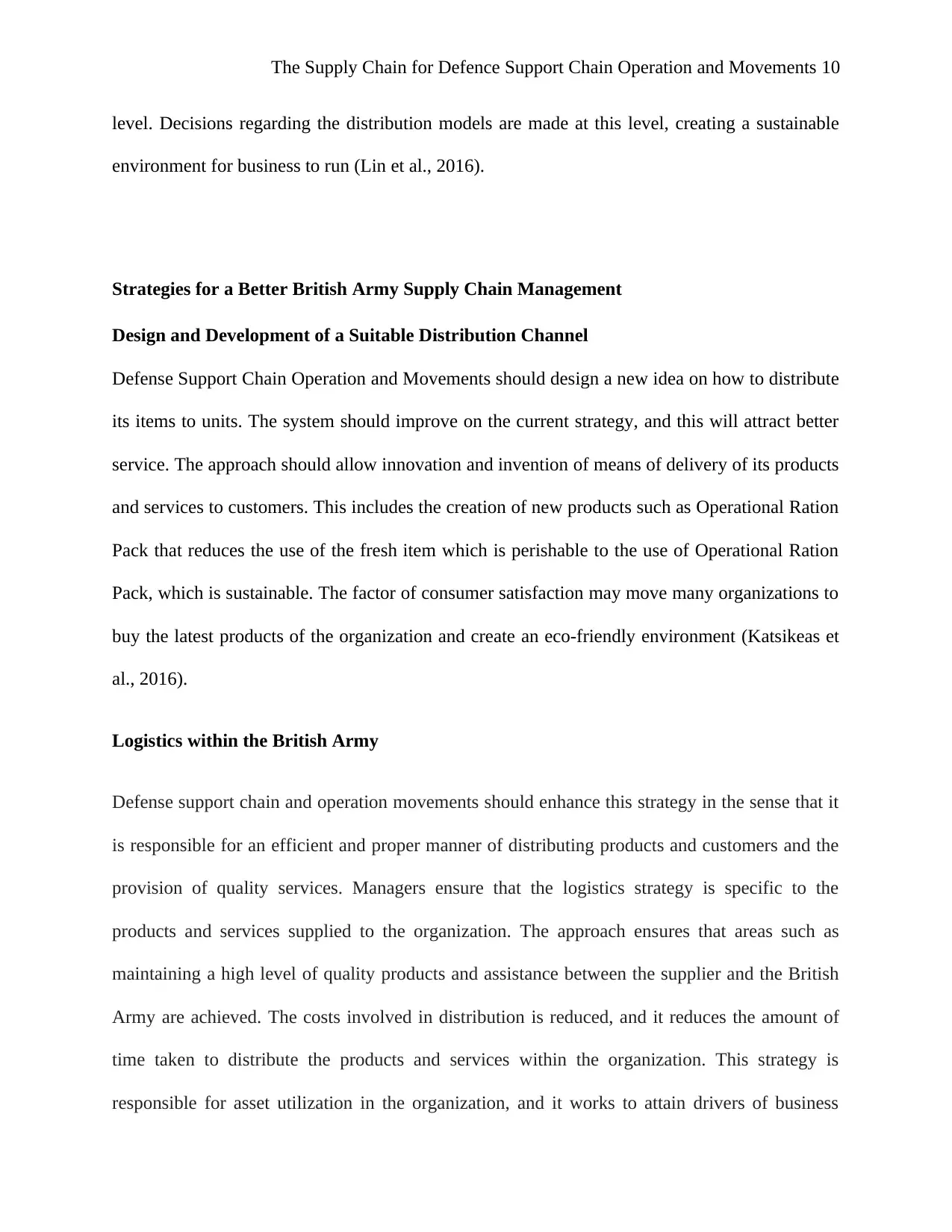
The Supply Chain for Defence Support Chain Operation and Movements 10
level. Decisions regarding the distribution models are made at this level, creating a sustainable
environment for business to run (Lin et al., 2016).
Strategies for a Better British Army Supply Chain Management
Design and Development of a Suitable Distribution Channel
Defense Support Chain Operation and Movements should design a new idea on how to distribute
its items to units. The system should improve on the current strategy, and this will attract better
service. The approach should allow innovation and invention of means of delivery of its products
and services to customers. This includes the creation of new products such as Operational Ration
Pack that reduces the use of the fresh item which is perishable to the use of Operational Ration
Pack, which is sustainable. The factor of consumer satisfaction may move many organizations to
buy the latest products of the organization and create an eco-friendly environment (Katsikeas et
al., 2016).
Logistics within the British Army
Defense support chain and operation movements should enhance this strategy in the sense that it
is responsible for an efficient and proper manner of distributing products and customers and the
provision of quality services. Managers ensure that the logistics strategy is specific to the
products and services supplied to the organization. The approach ensures that areas such as
maintaining a high level of quality products and assistance between the supplier and the British
Army are achieved. The costs involved in distribution is reduced, and it reduces the amount of
time taken to distribute the products and services within the organization. This strategy is
responsible for asset utilization in the organization, and it works to attain drivers of business
level. Decisions regarding the distribution models are made at this level, creating a sustainable
environment for business to run (Lin et al., 2016).
Strategies for a Better British Army Supply Chain Management
Design and Development of a Suitable Distribution Channel
Defense Support Chain Operation and Movements should design a new idea on how to distribute
its items to units. The system should improve on the current strategy, and this will attract better
service. The approach should allow innovation and invention of means of delivery of its products
and services to customers. This includes the creation of new products such as Operational Ration
Pack that reduces the use of the fresh item which is perishable to the use of Operational Ration
Pack, which is sustainable. The factor of consumer satisfaction may move many organizations to
buy the latest products of the organization and create an eco-friendly environment (Katsikeas et
al., 2016).
Logistics within the British Army
Defense support chain and operation movements should enhance this strategy in the sense that it
is responsible for an efficient and proper manner of distributing products and customers and the
provision of quality services. Managers ensure that the logistics strategy is specific to the
products and services supplied to the organization. The approach ensures that areas such as
maintaining a high level of quality products and assistance between the supplier and the British
Army are achieved. The costs involved in distribution is reduced, and it reduces the amount of
time taken to distribute the products and services within the organization. This strategy is
responsible for asset utilization in the organization, and it works to attain drivers of business
Paraphrase This Document
Need a fresh take? Get an instant paraphrase of this document with our AI Paraphraser
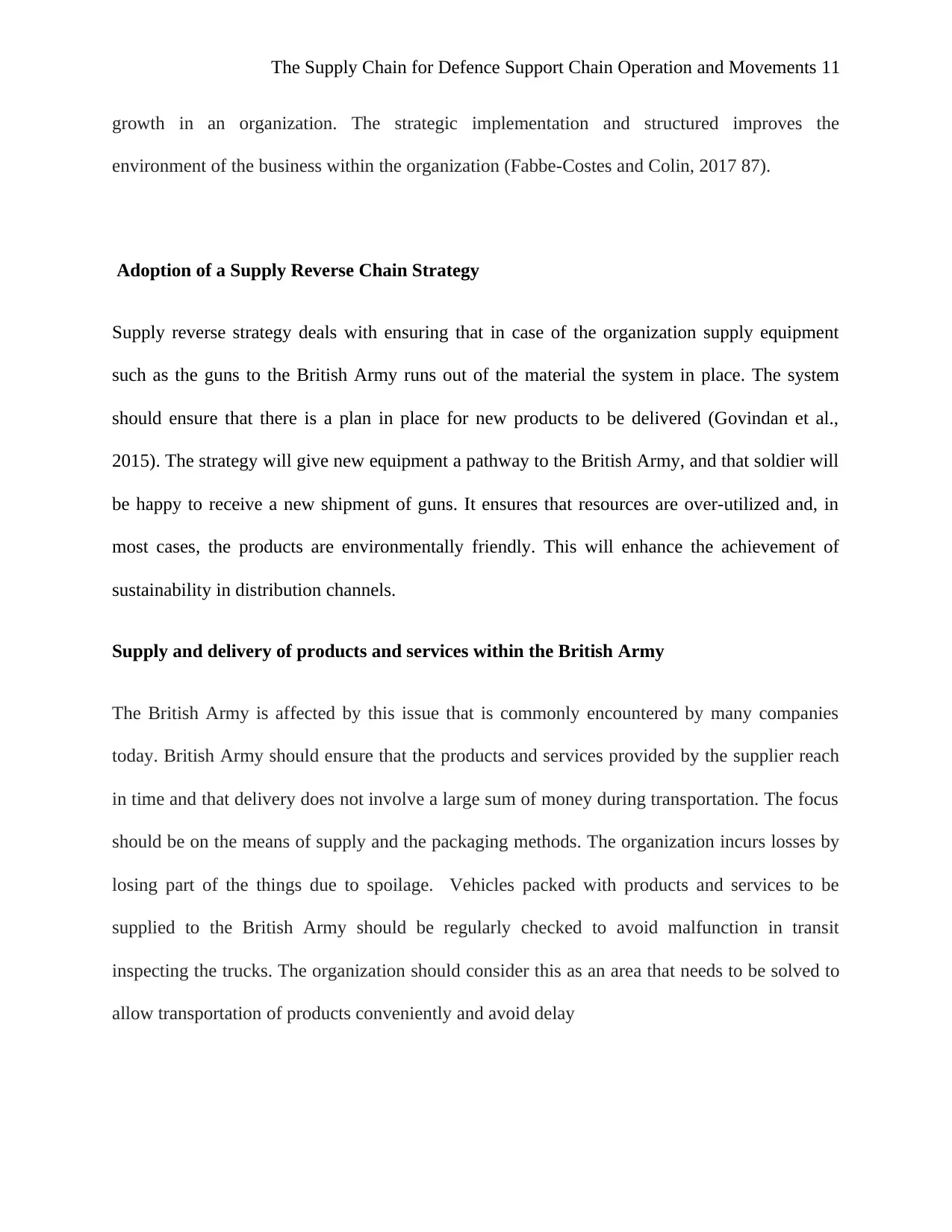
The Supply Chain for Defence Support Chain Operation and Movements 11
growth in an organization. The strategic implementation and structured improves the
environment of the business within the organization (Fabbe-Costes and Colin, 2017 87).
Adoption of a Supply Reverse Chain Strategy
Supply reverse strategy deals with ensuring that in case of the organization supply equipment
such as the guns to the British Army runs out of the material the system in place. The system
should ensure that there is a plan in place for new products to be delivered (Govindan et al.,
2015). The strategy will give new equipment a pathway to the British Army, and that soldier will
be happy to receive a new shipment of guns. It ensures that resources are over-utilized and, in
most cases, the products are environmentally friendly. This will enhance the achievement of
sustainability in distribution channels.
Supply and delivery of products and services within the British Army
The British Army is affected by this issue that is commonly encountered by many companies
today. British Army should ensure that the products and services provided by the supplier reach
in time and that delivery does not involve a large sum of money during transportation. The focus
should be on the means of supply and the packaging methods. The organization incurs losses by
losing part of the things due to spoilage. Vehicles packed with products and services to be
supplied to the British Army should be regularly checked to avoid malfunction in transit
inspecting the trucks. The organization should consider this as an area that needs to be solved to
allow transportation of products conveniently and avoid delay
growth in an organization. The strategic implementation and structured improves the
environment of the business within the organization (Fabbe-Costes and Colin, 2017 87).
Adoption of a Supply Reverse Chain Strategy
Supply reverse strategy deals with ensuring that in case of the organization supply equipment
such as the guns to the British Army runs out of the material the system in place. The system
should ensure that there is a plan in place for new products to be delivered (Govindan et al.,
2015). The strategy will give new equipment a pathway to the British Army, and that soldier will
be happy to receive a new shipment of guns. It ensures that resources are over-utilized and, in
most cases, the products are environmentally friendly. This will enhance the achievement of
sustainability in distribution channels.
Supply and delivery of products and services within the British Army
The British Army is affected by this issue that is commonly encountered by many companies
today. British Army should ensure that the products and services provided by the supplier reach
in time and that delivery does not involve a large sum of money during transportation. The focus
should be on the means of supply and the packaging methods. The organization incurs losses by
losing part of the things due to spoilage. Vehicles packed with products and services to be
supplied to the British Army should be regularly checked to avoid malfunction in transit
inspecting the trucks. The organization should consider this as an area that needs to be solved to
allow transportation of products conveniently and avoid delay
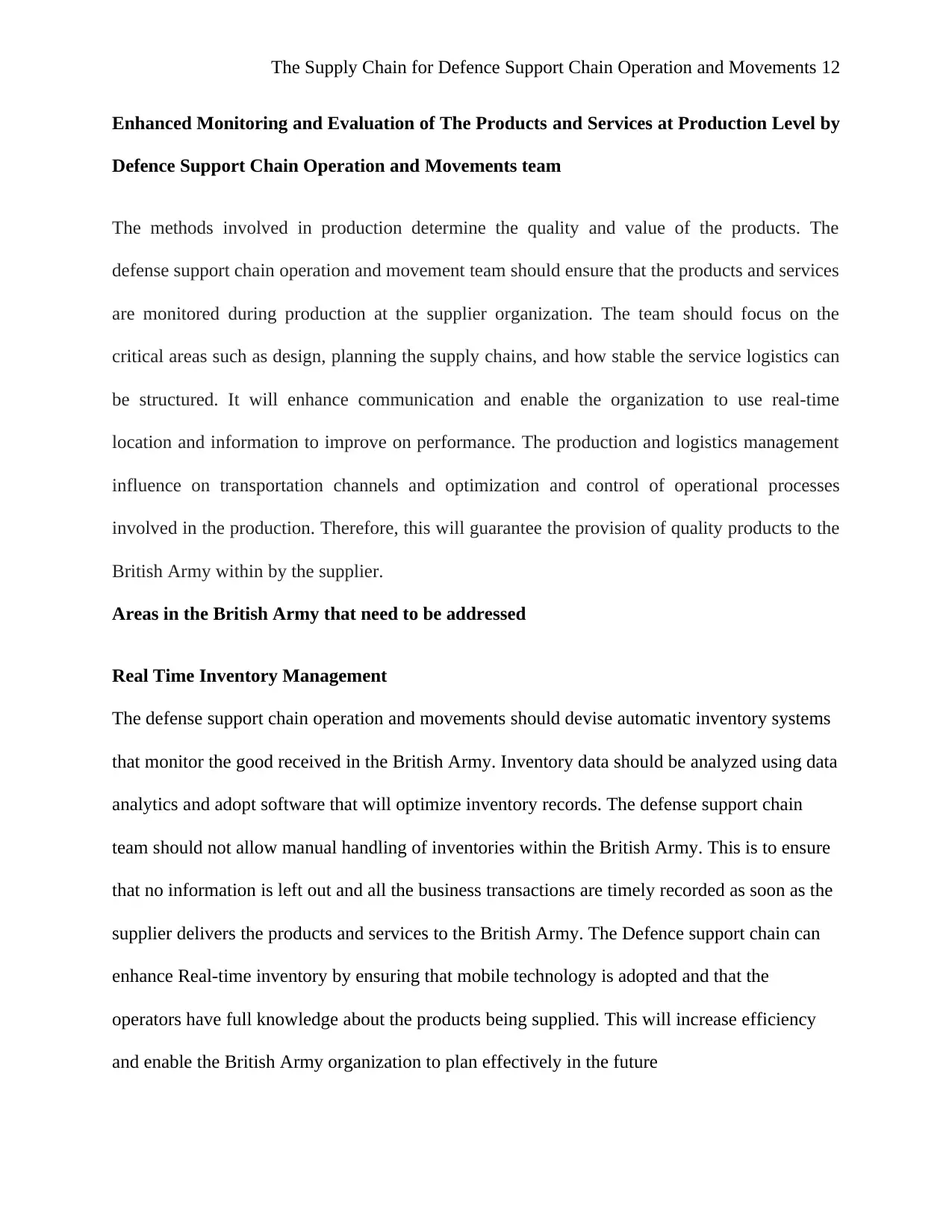
The Supply Chain for Defence Support Chain Operation and Movements 12
Enhanced Monitoring and Evaluation of The Products and Services at Production Level by
Defence Support Chain Operation and Movements team
The methods involved in production determine the quality and value of the products. The
defense support chain operation and movement team should ensure that the products and services
are monitored during production at the supplier organization. The team should focus on the
critical areas such as design, planning the supply chains, and how stable the service logistics can
be structured. It will enhance communication and enable the organization to use real-time
location and information to improve on performance. The production and logistics management
influence on transportation channels and optimization and control of operational processes
involved in the production. Therefore, this will guarantee the provision of quality products to the
British Army within by the supplier.
Areas in the British Army that need to be addressed
Real Time Inventory Management
The defense support chain operation and movements should devise automatic inventory systems
that monitor the good received in the British Army. Inventory data should be analyzed using data
analytics and adopt software that will optimize inventory records. The defense support chain
team should not allow manual handling of inventories within the British Army. This is to ensure
that no information is left out and all the business transactions are timely recorded as soon as the
supplier delivers the products and services to the British Army. The Defence support chain can
enhance Real-time inventory by ensuring that mobile technology is adopted and that the
operators have full knowledge about the products being supplied. This will increase efficiency
and enable the British Army organization to plan effectively in the future
Enhanced Monitoring and Evaluation of The Products and Services at Production Level by
Defence Support Chain Operation and Movements team
The methods involved in production determine the quality and value of the products. The
defense support chain operation and movement team should ensure that the products and services
are monitored during production at the supplier organization. The team should focus on the
critical areas such as design, planning the supply chains, and how stable the service logistics can
be structured. It will enhance communication and enable the organization to use real-time
location and information to improve on performance. The production and logistics management
influence on transportation channels and optimization and control of operational processes
involved in the production. Therefore, this will guarantee the provision of quality products to the
British Army within by the supplier.
Areas in the British Army that need to be addressed
Real Time Inventory Management
The defense support chain operation and movements should devise automatic inventory systems
that monitor the good received in the British Army. Inventory data should be analyzed using data
analytics and adopt software that will optimize inventory records. The defense support chain
team should not allow manual handling of inventories within the British Army. This is to ensure
that no information is left out and all the business transactions are timely recorded as soon as the
supplier delivers the products and services to the British Army. The Defence support chain can
enhance Real-time inventory by ensuring that mobile technology is adopted and that the
operators have full knowledge about the products being supplied. This will increase efficiency
and enable the British Army organization to plan effectively in the future
⊘ This is a preview!⊘
Do you want full access?
Subscribe today to unlock all pages.

Trusted by 1+ million students worldwide
1 out of 16
Related Documents
Your All-in-One AI-Powered Toolkit for Academic Success.
+13062052269
info@desklib.com
Available 24*7 on WhatsApp / Email
![[object Object]](/_next/static/media/star-bottom.7253800d.svg)
Unlock your academic potential
Copyright © 2020–2025 A2Z Services. All Rights Reserved. Developed and managed by ZUCOL.





